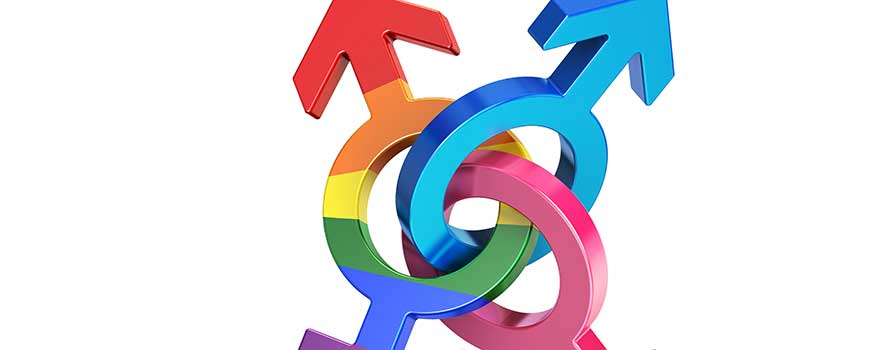Discrimination and stigma cause health disparities and differences in access to care that are closely linked to social, economic, and environmental disadvantages. In particular, members of the lesbian, gay, bisexual, transgender, and queer (or questioning) (LGBTQ) community experience societal, legal, and heathcare related barriers. Specifically, healthcare professionals may be unintentionally biased or have limited knowledge of the culture. Yet, RNs are called upon to provide quality, culturally sensitive care to the LGBTQ population.
The term transgender encompasses a wide range of behaviors and identities that reflect gender expression that differs from the sex assigned at birth. About 0.3% to 0.5% of the world’s population (25 million people) identify as transgender, according to the World Health Organization. And in a 2015 international study on gender identities by Tarynn Witten, 8% viewed themselves as neither 100% male nor 100% female. Hence, gender is increasingly being viewed and studied as a spectrum, not a binary “either-or.”
The marginalization of the margins
The 2015 U.S. Transgender Survey (USTS) is one of the largest surveys examining the experiences of transgender people in the United States, with over 27,000 respondents from all 50 states, the District of Columbia, American Samoa, Guam, Puerto Rico, and U.S. military bases. The survey findings reinforced continued marginalization of the transgender community in numbers far exceeding national averages. For example, close to one-third (29%) of respondents were living in poverty, compared to 14% in the general U.S. population, and 30% reported termination, denial of promotion, or mistreatment on the job in the prior year based on their gender identity.
In health-related concerns, close to 40% of respondents reported psychological trauma in the month before the survey compared to 5% in the general population, and approximately 40% had attempted suicide over their lifetime, nearly 9 times the national average. More than 75% of respondents reported mistreatment while in school (K-12) that has continued through adulthood, with nearly half of respondents reporting harassment or attempted sexual assault in their lifetime. For those identifying as transgender and also an ethnic minority, percentages of stigmatization and abuse were 6% to 10% higher.
Health care for the transgender community
In 2011, The Joint Commission issued a communication guide for appropriate, culturally congruent care of the LGBTQ community. Despite advances made in addressing the health needs of LGBTQ persons, disparities persist, particularly for individuals who identify as transgender. For example, in the Human Rights Campaign 2017 Health Equality Initiative (HEI), 70% of transgender respondents reported some type of discrimination in health care, as opposed to 56% who identified as lesbian, gay, or bisexual. Of the 590 hospitals and healthcare facilities participating in the HEI, 53% indicated they didn’t have an ombudsman or resident expert to facilitate transgender care and 27% of facilities acknowledged they didn’t provide any transgender specific services. While 93% of participating facilities reported having readily accessible nondiscrimination policies, only 61% of the policies included both sexual orientation and gender identity. Clinicians themselves are ill prepared to deal with distinct transgender issues such as the transitioned male-to-female (MTF) or femaleto- male (FTM), or those undergoing hormone therapy. In a recent study on transgender health in endocrinology, although 80% of the 411 respondents indicated they have treated a patient identifying as transgender, 80% stated they had never received training in transgender health needs. Barriers to formalized specialty training in transgender health topics included faculty inexperience and lack of interest.
ANA and culturally congruent care
ANA published the third edition of Nursing: Scope and Standards of Practice in 2015, and for the first time, the Standard of Culturally Congruent Practice was included. Per the standard, “Culturally congruent practice is the application of evidence-based nursing that is in agreement with the preferred cultural values, beliefs, worldview, and practices of the healthcare consumer and other stakeholders.” By embracing a culturally congruent mindset, nurses are in the best position to demonstrate inclusiveness, ensure better outcomes, and reduce health disparities. (See Delivering culturally congruent care.)
Nursing’s ethical obligations to the transgender community
Nurses have a social mandate to effect change in society where health, human rights, and human dignity are harmed. Nurses must be united leaders in health care to assist society and the healthcare system in overcoming transgender invisibility, unjust transgender discrimination, and social or cultural barriers to care, writes Marsha D. Fowler, PhD, in the Journal Nursing Inquiry in 2017.
ANA is concerned with the human rights of all individuals and is committed to address actions that are contrary to the respect of human dignity. Recently, ANA joined the Gay and Lesbian Medical Association and 18 other professional organizations in a friend-of-the-court brief to the U.S. Supreme Court supporting the scientific consensus outlining the harms associated with denying a transgender person use of facilities, including bathrooms that correspond with the individual’s gender identity.
Nurses are ethically obligated to respect every patient who requires and receives care. Furthermore, the Code of Ethics for Nurses with Interpretive Statements obligates nurses to practice with “compassion and respect for the inherent dignity, worth, and unique attributes of every person.” Factors such as sexual orientation and gender expression should be considered in individualized care planning to promote health and wellness, without introducing discrimination or bias.
Sharon A. Morgan is senior policy advisor in Nursing Practice & Work Environment at ANA. Liz Stokes is senior policy advisor at ANA’s Center for Ethics and Human Rights.
Selected references
Davidge-Pitts C, Nippoldt TB, Danoff A, Radziejewski L, Natt, N. Transgender health in endocrinology: Current status of endocrinology fellowship programs and practicing clinicians [published online ahead of print January 10, 2017]. J Clin Endocrinol Metab.
Fowler MD. ‘Unladylike commotion’: Early feminism and nursing’s role in gender/trans dialogue. Nurs Inq. 2017;24(1):e12179.
GLMA: Health Professionals Advancing LGBT Equality. GLMA stands with Gavin Grimm, joins brief in transgender student case. 2017.
Human Rights Campaign. Health equality index 2017: Celebrating a decade of promoting equitable and inclusive care for lesbian, gay, bisexual, transgender and queer patients and their families. 2017.
James SE, Herman JL, Rankin S, Keisling M, Mottet L, Anafi M. (2016). The Report of the 2015 U.S. Transgender Survey. Washington, DC: National Center for Transgender Equality; 2016.
Marion L, Douglas M, Lavin MA, et al. Implementing the new ANA Standard 8: Culturally congruent practice. Online J Issues Nurs. 2017;22(1).
Morgan SA, Stokes F. American Nurses Association. 2016 Membership Assembly: Report of the conference committee, Appendix A. June 25, 2016. Silver Spring, MD.
Thomas R, Pega F, Khosla R, Verster A, Hana T, Say L. Perspectives: Ensuring an inclusive global health agenda for transgender people. Bull World Health Organ. 2017;95(2):154-156.
Witten TM. Transgender aging: An emerging population and an emerging need [in French]. Sexologies, 2015:12(44).



















